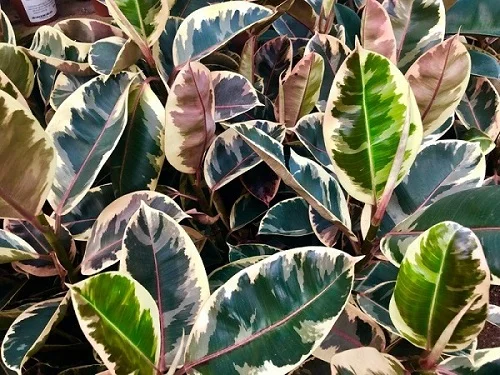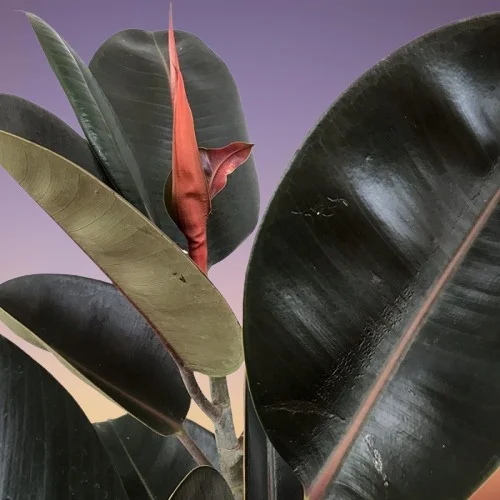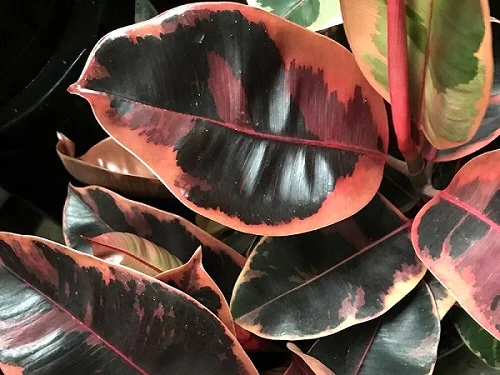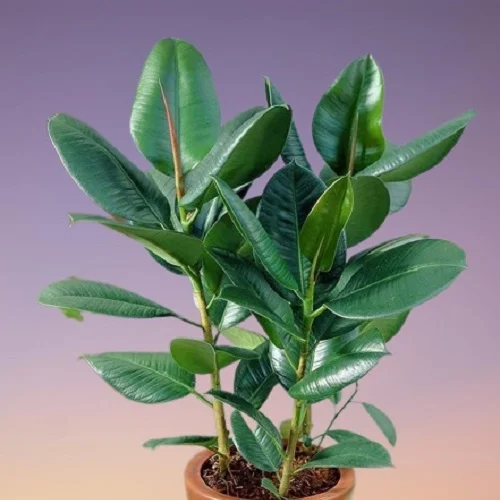13 Reasons Why Rubber Plant Leaves are Drooping and How to Fix It
Some links in this post may be affiliate links
Rubber Plant drooping leaves are caused by poor lighting, salts buildup, nutrients deficiency, root-rot, pests infestations, being pot-bound, inconsistent watering, temperature stress, low humidity among others.
Rubber Plants which go by the botanical name, Ficus elastica, are some of the easiest of the Ficus varieties for indoors and outdoors on account of their ability to adapt to varying growing conditions.
Ficus elastica prospers in bright light with 4-6 hours of direct sunshine, average warmth of 15-280C, humidity of 50-55% and moderately moist, fertile, well-drained soil. Learn how to grow and care for Rubber Plants.
If the growing conditions are not right, your Ficus elastica leaves may begin to wilt and droop. If you fail to carry out timely corrective measures the plant will continue to deteriorate and may die. We have herebelow discussed 13 reasons why your Rubber Plant leaves are droopy and how to fix them.

13 Reasons why Rubber Plant leaves are drooping and their Solutions
1. Poor Lighting
Rubber Plants like all plants need adequate ligh to make food that is required for energy and growth. Insufficient light implies that the plant cannot make enough food for energy and growth.
In an attempt to save energy, the leaves begin to wilt, droop, yellow and eventually drop. This way, the energy available is saved for the vital functions to keep it alive.
Solutions
Move your Rubber Plant to a brighter spot where it will receive bright light with 4-6 hours of sunlight. A spot infront of a brightly lit window which receives 4-6 hours of morning or late afternoon sunlight is ideal for the plant.
If you do not have adequate lighting in your home, consider investing in grow lights to supplement it.
To ensure that the plant absorbs enough light through the leaves, regularly clean the leaves by damp-wiping with a soft cloth.
Rotate the pot every so often to make sure that the plant receives adequate light on all sides.
2. Salts Buildup
Excess salts in the soil will cause the roots to die due to fertilizer burn. This means the roots cannot take up water to the leaves. Since the water loss in the leaves is greater that the replacement, the leaves begin wilting and drooping.
Solutions
Use chemical free water like rain water or filtered water to water your Rubber Plant to prevent buildup of salts in the soil.
Do not feed in the cold season as growth is minimal at this time therefore, the plant does not need it. Feeding the plant at this time may result in fertilizer burn and death of the plant.
Occasionally flush out accumulated salts by running a stream of water through the soil until it drains through the drainage hole. Repeat the process several times to clear the salts.
3. Nutrients Deficiency
Underfeeding your Rubber Plant implies that the plant is not getting the nutrients need for growth and energy. Inadequate nutrients in the actively growing tips causes nutrients to be withdrawn from the older lower leaves which begin to wilt and droop.
Solutions
Feed your Rubber Plant monthly in spring and summer with a balanced, water-soluble fertilizer and ensure to follow the instructions on the label.

4. Root-rot Disease
Rubber Plant is prone to root-rot disease which is prevalent in soggy soil. The disease is characterized by wilting, drooping, discolored leaves, corky swellings under the leaves and eventual plant death.
The soggy soil drastically reduces oxygen concentration in the soil which causes the roots to die. Once the roots die, they cannot take up water to the leaves. The leaves begin to wilt, droop and eventually drop.
Solutions
Carefully, slip your Rubber Plant out of its pot and inspect the roots; brown-black mushy roots indicate root-rot, trim them off.
Treat the healthy roots with a fungicidal solution as recommended by the manufacturer.
Disinfect the pot with the fungicidal solution or use a fresh pot to repot the plant in fresh, well-drained soil.
Ensure that the pot has a drainage hole to prevent the soil getting soggy.
Do not water the plant immediately and keep it dry for a few days before you can resume watering.
5. Poor Quality Soil
Poor quality soil does not drain easily and therefore it easily becomes compacted or soggy which can negatively impact the growth leading to drooping leaves. Soggy soil can lead to rotting, yellowing and droopy leaves.
Solutions
Pot your Rubber Plant in good quality soil that is loose, well-draining and rich in organic matter. All purpose potting mixes are good for this plant.
6. Pest Infestations
Rubber Plant is prone to mealybugs>, aphids, spider mites and scale insects which attack the new growth from where they suck the plant sap. These sap sucking insects are favored by dry conditions and they will cause the plant to be dehydrated resulting in wilting and drooping leaves.
Solutions
Regularly inspect your Rubber Plant for these pests and take timely control measures.
Isolate the affected plant to minimize spread to the rest of the plants.
Treat the infested plant with neem oil or insecticidal soap as per the manufacturers' recommendations.
Raise the humidity to discourage pests, by setting the pot on a wet pebble tray or by use of a cool mist humidifier.
Regularly clean the leaves by damp-wiping with a soft cloth and keep it properly pruned.

7. Being Pot-bound
If your Rubber Plant is pot-bound, the roots have filled the pot and there is very little soil to hold water when you water the plant. Therefore, there is no water for the plant to take up to the leaves. The leaves loss their stiffness and they begin to wilt and droop.
Solutions
Check the bottom of the pot for roots growing through the drainage hole.
Repot your Rubber Plant into a pot one size larger than the current one. Confirm that the pot has a drainage hole and that the soil is well-draining. Use a heavy pot as the plant can become top-heavy and topple over. Take a look at these ceramic pots with a drainage hole on Amazon.
8. Repotting Shock
Repotting your Rubber Plant will cause it some shock which may lead to some leaves wilting and drooping before it can adjust the new growing conditions.
Solutions
To minimize repotting shock, water your Rubber Plant thoroughly one day before repotting as a well hydrated plant experiences less shock and establishes faster.
Do not make too many changes at once. For instance, after repotting, maintain the plant in the same location until it is well established before moving it to a new location.
9. Soggy Soil
Overwatering your Rubber Plant will result in excess water in soggy soil. Too much water in the soil will reduce the oxygen concentration in the rootzone which can cause the roots to die.
When roots die, they cannot take up water to the upper parts of the plant including the stems and leaves. These parts lose their turgidy (firmness), therefore, the leaves begin to wilt and droop.
Solutions
Ensure that the pot has a drainage hole and that the soil drains easily.
Decrease watering in fall and winter to maintain the soil barely moist as growth is minimal at this time.
10. Inconsistent Watering
Both underwatering and overwatering negatively affect the growth of the plant. Underwatering causes wilting, drooping, yellowing, leaf drop and eventual death of the plant.
On the other hand, overwatering results in soggy soil which causes rotting, yellowing, leaf fall and death of the plant if not corrected.
Solutions
Immediately, thoroughly water your Rubber Plant when you realise it is drooping and it should perk up.
Thereafter, water when the top 2-3 inches of soil dry out but do not allow the soil to dry out completely.

11. Temperature Stress
Extreme temperatures brought about by exposure to drafts will result in reduced growth which will cause wilting, drooping, yellowing and shedding of leaves.
Solutions
Keep your Rubber Plant away from sources of drafts like hot surfaces, hot air vents, AC units, drafty windows, windy doors and others.
Maintain an average warmth of 15-280C. Usually, a room temperature that is comfortable for you is ideal for the plant.
12. Low Humidity
Though your Rubber Plant will grow in ordinary room humidity, a humid environment is necessary for lush growth especially where the air is too dry. Too little humidity will lead to dehydration which will cause the leaves to lose their turgidity and begin to wilt and droop.
Solutions
To upscale humidity, set the pot on a wet pebble tray, use a cool mist humidifier or group the plants together.
13. Too Cold Water
Rubber Plant is a tropical plant which grows in consistently warm temperatures in its natural habitat. Therefore, watering it with very cold water will shock the plant causing it to wilt, droop and shed its leaves.
Solutions
Water your Rubber Plant with room temperature water to avoid cold shock which may lead to stunted growth and eventual death of the plant.
You liked it? Share on social media.
Related Content
Amazon Associates Disclosure
Homeplantsguide.com is a participant in the Amazon Services LLC Associates Program, an affiliate advertising program designed to provide a means for sites to earn advertising fees by advertising and linking to amazon.com.




